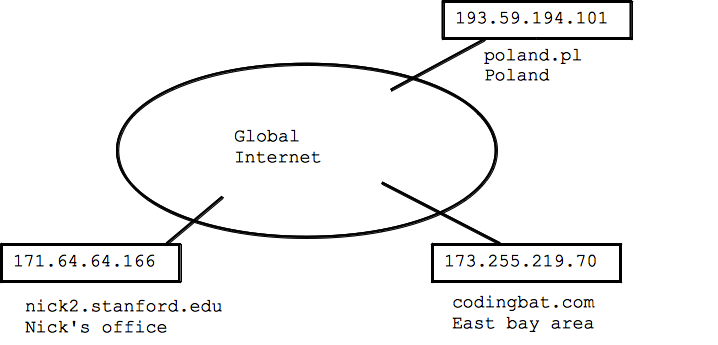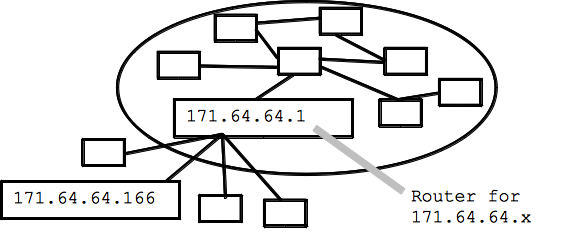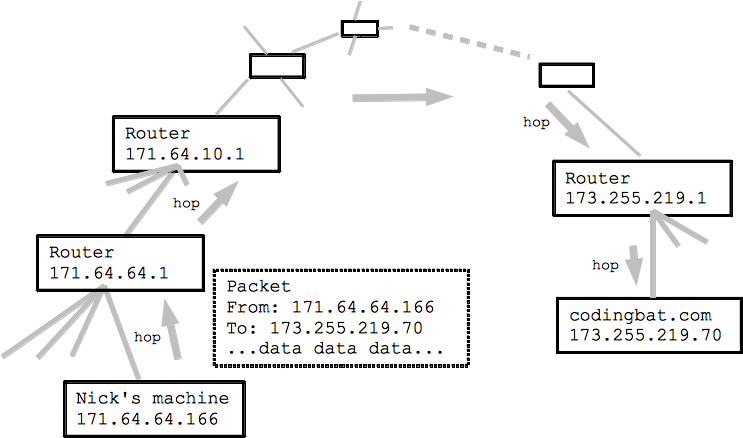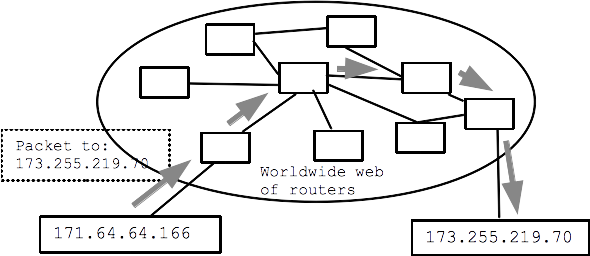The Internet - TCP/IP
The Internet Runs On Standards
Interoperate - The internet involves equipment like computers, routers, phones, browsers etc. formatting bytes, and sending them to some other piece of equipment. This only works if the various parties agree on a standard format for the bytes. There were early attempts at "corporate" standards, Microsoft or IBM would control the format. This was a total failure.
The successful solution was "open standards" - standards not under the control of any one vender. Anyone is free to read an implement the standard, no fee, no patents, no permission required. Open standards turned out to be the key enabler to the internet as we know it today.
You can buy a GE coffee maker, but you are not then required to buy the GE
plug and cord and power supply. The plug is a standard, anything plugs into it. TCP/IP!

Internet - TCP/IP Standards
The previous LAN examples connect computers all on the same LAN. Now we will scale the problem up to send packets between any two computers on earth.
The worldwide Internet is built on the TCP/IP family of standards (Transmission Control Protocol / Internet Protocol) which solves the larger problem of sending packets between computers across the whole internet. These are free and open, vendor-neutral standards which is probably the reason they have been so incredibly successful.
IP Address

Every computer on the internet has an "IP address" that identifies it (like a phone number). The IP address is 4 bytes, written between dots, like "171.64.2.3". The left part of the address encodes in part where that IP address is in the whole internet -- for example any 171.64.(anything) is part of Stanford (like the area code of a phone number). More specifically, in my part of the Gates building, all the IP addresses begin 171.64.64.XX varying only in that last byte.
Sandra Bullock Blooper
TCP/IP blooper in this video of "The Net"...
Domain Names
Router

The most common way for a computer to be "on the internet" is to establish a connection with a "router" which is already on the internet. The computer establishes a connection via, say, ethernet to communicate packets with the router. The router is "upstream" of the computer, connecting the computer to the whole internet. For example, the computer in my Stanford office has IP address 171.64.64.166, and it has a one-hop ethernet connection to its router upstream at 171.64.64.1, and this router handles packets for my computer. Often the router's IP address will end in .1, such as my router's 171.64.64.1. Typically the IP address of the computer and its router will look at the same on the left side, since they are in the same "neighborhood" of the internet.
IP Packet - From: and To: IP Addresses
That's A Lot Of Hopping!
How does a packet get around the internet? Answer: Hop Hop Hop Hop Hop Hop Hop Hop Hop. Strange but true.

Suppose my computer at 171.64.64.166 wants to send a packet to a computer at 173.255.219.70 somewhere out on the internet (actually that's the codingbat.com server I administer). The Internet is essentially made of a big web of routers talking to each other.
1. My computer prepares an IP packet which includes in particular From:/To: information as IP addresses, like this: (IP Packet From:171.64.64.166 To:173.255.219.70 data data data data).
2. My computer sends that IP packet to my upstream router, one hop, over ethernet. This is the "first hop" of the packet on its journey.
3. The 171.64.64.1 router looks at the To:/From: of the packet and forwards it to the next router, one hop closer to its ultimate destination. Essentially, the router has its own upstream router which is bigger and knows more about the layout of the internet. The packet is forwarded, one hop at a time, until it reaches its ultimate destination. Each router does not need to know the whole route to the destination; each router just needs to know which way to send the packet to get it one-hop closer to its destination. The routers look at the left part of the IP address to get the packet to the right neighborhood -- 173.255.x.x -- with the right part of the address -- x.x.219.70 -- coming into play only when the packet is near its ultimate destination.
Router Analysis
The routing of a packet from your computer is like a capillary/artery system .. your computer is down at the capillary level, your packet gets forwarded up to larger and larger arteries, makes its way over to the right area, and then down to smaller and smaller capillaries again, finally arriving at its destination. The ultimate destination puts all the packets back together in the right order to recover the original image file or whatever. The routers at the ends have a trivial upstream/downstream configuration, so the next hop for a packet is pretty simple. More central "core" routers tend to have several possible outgoing connections, so they have a more complicated choice about which link to use for the next hop.
The routers, collectively, measure what networks are reachable over what links, and dynamically adjust what links to use for each packet. One simple metric would be to route packets the way that takes the fewest number of hops. In reality, the metrics used are more complex than this. The routing system resilient to router hardware failures, overloading of certain links due to normal traffic, and links going down. The path taken by an IP packet can change from minute to minute. The routers are another example of a distributed, collaborative system. The old joke is that the backhoe is the IP packet's natural predator in the wild, as construction will sometimes slice through an important data cable, suddenly breaking a link in use. The routers "route around" such damage automatically.
Note that my computer does not need to know the layout of the internet. My computer just needs to have a connection to its upstream router, and the router, and its upstream router etc., will handle the routing from there.
Very broadly speaking, most data you get or send on the Internet goes in packets which take more than 10 but less than 20 hops from origin to destination.
Paying For Internet Service
Special "Local" IP Addresses
What Does it Mean to Be On the Internet?
So what does it mean for a computer to be on the internet? Typically it means the computer has established a connection with a router. The commonly used DHCP standard (Dynamic Host Configuration Protocol), facilitates connecting to a router; establishing a temporary connection, and the router gives your computer an IP address to use temporarily. Typically DHCP is used when you connect to a Wi-Fi access point.
Experiment: bring up the networking control panel of your computer. It should show what IP address you are currently using and the IP address of your router. You will probably see some text mentioning that DHCP is being used.
Demo: DNS Lookup
Here I use the "host" program to look up the IP addr of a domain name. You don't have to do this; I'm just demoing.
$ host codingbat.com # I type in a command here codingbat.com has address 173.255.219.70 codingbat.com mail is handled by 10 mx01.1and1.com. codingbat.com mail is handled by 10 mx00.1and1.com. $ host www.google.com www.google.com has address 216.58.217.196 www.google.com has IPv6 address 2607:f8b0:4007:808::2004
Demo: Ping
"Ping" is an old and very simple internet utility. Your computer sends a "ping" packet to any computer on the internet, and the computer responds with a "ping" reply (not all computers respond to ping). In this way, you can check if the other computer is functioning and if the network path between you and it works. As a verb, "ping" is also used in regular English this way .. not sure if that's from the internet or the other way around.
Experiment: Most computers have a ping utility, or you can try "ping" on the command line. Try pinging www.google.com or pippy.stanford.edu (171.64.64.28, on nick's desk). Try pinging poland.pl ... much farther away from Stanford.
Milliseconds fraction of a second used for the packet to go and come back. 1 ms = 1/1000 of a second. Different from bandwidth, this "round trip delay".
Here I run the "ping" program for a few addresses, see what it reports
$ ping www.google.com # I type in a command here PING www.l.google.com (74.125.224.144): 56 data bytes 64 bytes from 74.125.224.144: icmp_seq=0 ttl=53 time=8.219 ms 64 bytes from 74.125.224.144: icmp_seq=1 ttl=53 time=5.657 ms 64 bytes from 74.125.224.144: icmp_seq=2 ttl=53 time=5.825 ms ^C # Type ctrl-C to exit --- www.l.google.com ping statistics --- 3 packets transmitted, 3 packets received, 0.0% packet loss round-trip min/avg/max/stddev = 5.657/6.567/8.219/1.170 ms $ ping pippy.stanford.edu PING pippy.stanford.edu (171.64.64.28): 56 data bytes 64 bytes from 171.64.64.28: icmp_seq=0 ttl=64 time=0.686 ms 64 bytes from 171.64.64.28: icmp_seq=1 ttl=64 time=0.640 ms 64 bytes from 171.64.64.28: icmp_seq=2 ttl=64 time=0.445 ms 64 bytes from 171.64.64.28: icmp_seq=3 ttl=64 time=0.498 ms ^C --- pippy.stanford.edu ping statistics --- 4 packets transmitted, 4 packets received, 0.0% packet loss round-trip min/avg/max/stddev = 0.445/0.567/0.686/0.099 ms
Traceroute
Traceroute is a program that will attempt to identify all the routers in between you and some other computer out on the internet - demonstrating the hop-hop-hop quality of the internet. Most computers have some sort of "traceroute" utility available if you want to try it yourself (not required). Some routers are visible to traceroute and some not, so it does not provide completely reliable output. However, it is a neat reflection of the hop-hop-hop quality of the internet. Here's an example traceroutes from my office, and then a randomly chosen computer with a Serbia (.rs) domain name.
$ traceroute -q 1 codingbat.com # typing a command to the computer traceroute to codingbat.com (173.255.219.70), 64 hops max, 52 byte packets 1 yoza-vlan70 (171.64.70.2) 2.039 ms 2 bbra-rtr-a (171.64.255.129) 0.932 ms 3 boundarya-rtr (172.20.4.2) 3.174 ms 4 dca-rtr (68.65.168.51) 27.085 ms 5 dc-svl-agg1--stanford-10ge.cenic.net (137.164.50.157) 2.485 ms 6 dc-oak-core1--svl-agg1-10ge.cenic.net (137.164.47.123) 3.262 ms 7 dc-paix-px1--oak-core1-ge.cenic.net (137.164.47.174) 4.046 ms 8 hurricane--paix-px1-ge.cenic.net (198.32.251.70) 14.252 ms 9 10gigabitethernet1-2.core1.fmt1.he.net (184.105.213.65) 9.117 ms 10 linode-llc.10gigabitethernet2-3.core1.fmt1.he.net (64.62.250.6) 4.975 ms 11 li229-70.members.linode.com (173.255.219.70) 4.761 ms $ traceroute -q 1 yujor.fon.bg.ac.rs traceroute to hostweb.fon.bg.ac.rs (147.91.128.13), 64 hops max, 52 byte packets 1 csmx-west-rtr.sunet (171.64.64.2) 32.802 ms 2 171.64.255.204 (171.64.255.204) 0.478 ms 3 dc-svl-agg1--stanford-10ge.cenic.net (137.164.50.157) 0.972 ms 4 dc-svl-core1--svl-agg1-10ge.cenic.net (137.164.47.121) 2.784 ms 5 hpr-svl-hpr2--svl-core1.cenic.net (137.164.26.249) 1.107 ms 6 lax-hpr2--svl-hpr2-10g-2.cenic.net (137.164.25.49) 13.880 ms 7 hpr-i2-newnet--lax-hpr.cenic.net (137.164.26.134) 9.213 ms # See the ms go way up here 8 et-1-0-0.111.rtr.hous.net.internet2.edu (198.71.45.20) 41.892 ms # houston 9 et-10-0-0.105.rtr.atla.net.internet2.edu (198.71.45.12) 65.663 ms # atlanta 10 et-9-0-0.104.rtr.wash.net.internet2.edu (198.71.45.7) 78.620 ms # DC 11 abilene-wash.mx1.fra.de.geant.net (62.40.125.17) 179.285 ms # jumped the Atlantic 12 ae0.mx1.pra.cz.geant.net (62.40.98.52) 179.336 ms 13 ae2.mx2.bra.sk.geant.net (62.40.98.55) 183.670 ms 14 ae0.mx1.bud.hu.geant.net (62.40.98.110) 199.815 ms 15 amres-gw.mx1.bud.hu.geant.net (62.40.125.178) 207.006 ms 16 amres-l-j-agg.rcub.bg.ac.rs (147.91.6.85) 193.146 ms 17 cisco3550-fon.rcub.bg.ac.rs (147.91.7.92) 193.536 ms 18 rcub-fon-gw4.rcub.bg.ac.rs (147.91.5.172) 193.758 ms 19 hostweb.fon.bg.ac.rs (147.91.128.13) 208.213 ms
The numbers down the left side are the number of "hops" to that machine. The "ms" figures are the number of milliseconds (1 ms = 1 thousandth of a second) it took for the send/reply. Notice that as the hops get further away, it does roughly take more milliseconds. The first few hops are Stanford addresses, then the route goes over some provider, until it arrives at Linode, which is the company that provides the hardware where codingbat.com currently lives. Small mystery: it seems like the first hop should be 171.64.64.1 which is the first router from my office; apparently that router is invisible to traceroute.
Internet and the Speed of Light
Here's a traceroute of a computer in london, ae-9.r24.londen12.uk.bb.gin.ntt.net. I did a traceroute of theregister.co.uk to get this ae-xxx IP in London.
$ traceroute -q 1 ae-9.r24.londen12.uk.bb.gin.ntt.net traceroute to ae-9.r24.londen12.uk.bb.gin.ntt.net (129.250.2.19), 64 hops max, 52 byte packets 1 csmx-west-rtr-vl3864.sunet (171.64.64.2) 1.231 ms 2 dc-svl-rtr-vl8.sunet (171.64.255.204) 0.562 ms 3 dc-svl-agg4--stanford-100ge.cenic.net (137.164.23.144) 1.212 ms 4 10-1-1-91.ear1.sanjose1.level3.net (4.15.122.45) 1.416 ms 5 ae-1-2.ear1.sanjose3.level3.net (4.69.209.149) 2.256 ms 6 ntt-level3-4x10g.sanjose.level3.net (4.68.62.206) 3.908 ms 7 ae-1.r02.snjsca04.us.bb.gin.ntt.net (129.250.3.59) 2.298 ms 8 ae-11.r23.snjsca04.us.bb.gin.ntt.net (129.250.6.118) 1.801 ms 9 ae-3.r21.sttlwa01.us.bb.gin.ntt.net (129.250.3.125) 21.240 ms 10 ae-0.r20.sttlwa01.us.bb.gin.ntt.net (129.250.2.53) 19.918 ms 11 ae-0.r24.nycmny01.us.bb.gin.ntt.net (129.250.4.14) 79.439 ms 12 ae-9.r24.londen12.uk.bb.gin.ntt.net (129.250.2.19) 163.360 ms
Note: last 2 lines: new york 79 ms, london 163 ms
Now try London too
TCP/IP Summary Picture
